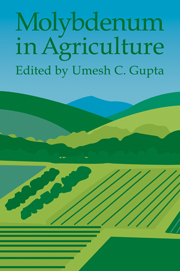Book contents
- Frontmatter
- Contents
- List of contributors
- Preface
- 1 Introduction
- 2 Chemistry and Mineralogy of Molybdenum in Soils
- 3 Distribution and Mobility of Molybdenum in the Terrestrial Environment
- 4 Biochemical Significance of Molybdenum in Crop Plants
- 5 Soil and Plant Factors Affecting Molybdenum Uptake by Plants
- 6 Analytical Techniques for Molybdenum Determination in Plants and Soils
- 7 Testing for Molybdenum Availability in Soils
- 8 Molybdenum Availability in Alkaline Soils
- 9 Deficient, Sufficient, and Toxic Concentrations of Molybdenum in Crops
- 10 Symptoms of Molybdenum Deficiency and Toxicity in Crops
- 11 Sources and Methods for Molybdenum Fertilization of Crops
- 12 Yield Responses to Molybdenum by Field and Horticultural Crops
- 13 Responses of Forage Legumes and Grasses to Molybdenum
- 14 Molybdenum and Sulfur Relationships in Plants
- 15 Molybdenum in the Tropics
- Index
6 - Analytical Techniques for Molybdenum Determination in Plants and Soils
Published online by Cambridge University Press: 10 December 2009
- Frontmatter
- Contents
- List of contributors
- Preface
- 1 Introduction
- 2 Chemistry and Mineralogy of Molybdenum in Soils
- 3 Distribution and Mobility of Molybdenum in the Terrestrial Environment
- 4 Biochemical Significance of Molybdenum in Crop Plants
- 5 Soil and Plant Factors Affecting Molybdenum Uptake by Plants
- 6 Analytical Techniques for Molybdenum Determination in Plants and Soils
- 7 Testing for Molybdenum Availability in Soils
- 8 Molybdenum Availability in Alkaline Soils
- 9 Deficient, Sufficient, and Toxic Concentrations of Molybdenum in Crops
- 10 Symptoms of Molybdenum Deficiency and Toxicity in Crops
- 11 Sources and Methods for Molybdenum Fertilization of Crops
- 12 Yield Responses to Molybdenum by Field and Horticultural Crops
- 13 Responses of Forage Legumes and Grasses to Molybdenum
- 14 Molybdenum and Sulfur Relationships in Plants
- 15 Molybdenum in the Tropics
- Index
Summary
Introduction
Molybdenum (Mo) has been the subject of many investigations since Arnon and Stout (1939) first showed that Mo is essential for higher plants. The biological importance of Mo was reported to lie in the processes of nitrogen (N) fixation and nitrate reduction (Bortels, 1936; Mulder, 1948). The literature on Mo in soils, plants, and animals has been reviewed by Gupta and Lipsett (1981). Because Mo plays important roles in plant and animal nutrition and is an environmental concern (Council for Agricultural Science and Technology, 1976; U.S. Environmental Protection Agency, 1993), a critical study of the analytical procedures available for Mo determinations is warranted.
In general, selection of a particular analytical method or technique to measure an element of interest is based on the availability of the proper instrumentation and facilities. The characteristics of the analytical instrument used and the acceptable limits of variability, with emphasis on sensitivity, reproducibility, and specificity, are determining factors in selecting a technique. These issues are particularly important for determinations of micronutrients, because the critical concentrations of these elements for plants can be close to the limits of detection for most analytical procedures. Also, one's ability to determine true values using any method is dependent on the use of reliable standards (Alvarez, 1980; Taylor, 1985), the precision of the analytical procedure (Horwitz, 1982; Dux, 1986), and careful evaluation at each step in the analytical process (Sterrett et al., 1987; Munter, Halverson, and Anderson, 1984).
- Type
- Chapter
- Information
- Molybdenum in Agriculture , pp. 92 - 110Publisher: Cambridge University PressPrint publication year: 1997



